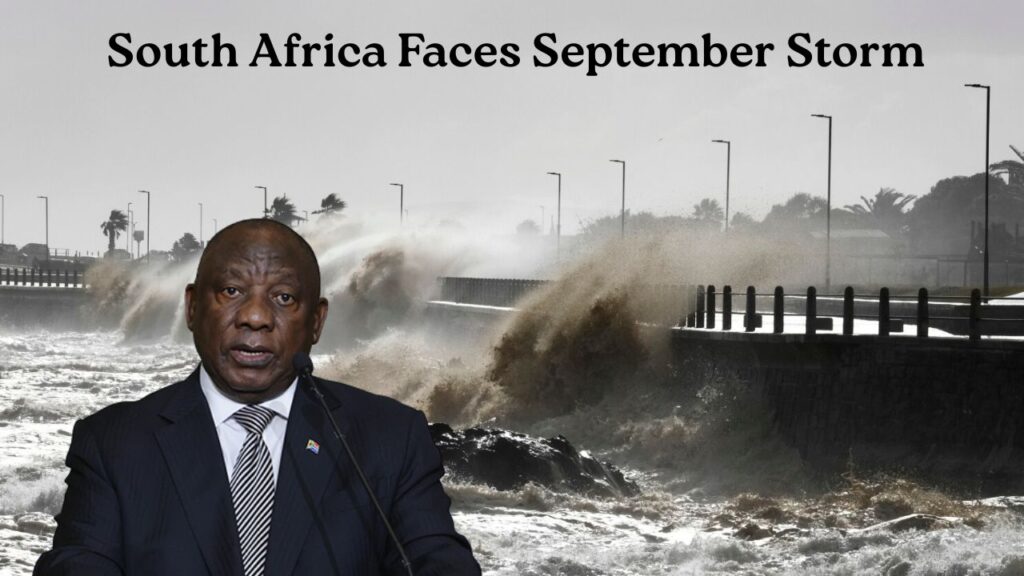South Africa Weather Alert – South Africans are being urged to prepare as the South African Weather Service (SAWS) has issued a strong weather alert for September 2025, warning of heavy rains, thunderstorms, and strong winds across multiple provinces. These conditions are expected to affect daily life, transportation, and infrastructure, especially in vulnerable regions prone to flooding and storm damage. Residents are advised to remain cautious, as continuous rainfall could increase the risk of overflowing rivers, flash floods, and landslides in mountainous areas. The alert also mentions that informal settlements, rural areas, and low-lying regions may face the highest risks, with possible disruptions to essential services. Communities are being encouraged to follow official safety guidelines and stay informed about local updates through radio, television, and mobile alerts. Farmers and businesses relying on outdoor operations are also being warned to take precautions to protect livestock, crops, and property. The September storm warnings highlight the importance of preparedness and community cooperation to minimize potential damage.

Regions Most Affected by the Weather Alert
The September 2025 weather alert highlights several provinces that are expected to experience the most severe impact. KwaZulu-Natal, Eastern Cape, and Mpumalanga are among the regions where heavy downpours and thunderstorms could lead to dangerous flooding. Gauteng and parts of the Free State may also experience stormy conditions, disrupting road travel and causing potential delays at airports. Coastal provinces, including the Western Cape, face an additional risk of strong winds, which could result in rough seas and hazardous conditions for fishermen and maritime activities. The SAWS has cautioned that areas with poor drainage systems are particularly vulnerable to flooding. Local authorities are preparing emergency response teams to assist communities, especially in regions where infrastructure is weak. Residents in these provinces are strongly encouraged to monitor updates closely and avoid unnecessary travel during peak storm periods to ensure safety.
Safety Measures for Communities
Authorities are urging residents to take proactive steps to minimize the risks posed by the September 2025 heavy rains and storms. Households in flood-prone areas should secure important documents, food supplies, and drinking water in case of emergencies. People are advised to avoid crossing swollen rivers or driving on flooded roads, as even shallow water can be life-threatening. Electricity users should unplug appliances during lightning activity to prevent damage from power surges. Communities are also encouraged to assist vulnerable groups, including the elderly and children, by ensuring they remain safe and sheltered. Farmers are being reminded to move livestock to higher ground and protect their crops where possible. Emergency shelters and hotlines are being set up in several regions, providing assistance to those displaced by flooding. By following these safety measures, South Africans can reduce the risks associated with the upcoming storms and safeguard their families and properties.
Impact on Transportation and Daily Life
The September weather alert is expected to cause significant disruptions to transportation and daily routines. Flooded roads, damaged bridges, and reduced visibility from heavy rain may make travel hazardous, leading to delays in both public and private transport. In urban areas, traffic congestion is likely to worsen as certain routes become impassable. Rail and bus services may also be affected, with potential cancellations or rescheduling to ensure passenger safety. Airlines have been advised to prepare for delays, especially in storm-affected provinces. For schools and workplaces, authorities may implement temporary closures or remote working measures if conditions worsen. Residents should prepare for potential power outages caused by storms, which may impact communication and essential services. Stocking up on food, candles, and emergency supplies is strongly recommended. Overall, the storm warnings are expected to influence the daily lives of millions, reinforcing the need for thorough preparation and flexibility.
Government and Emergency Response
In anticipation of the heavy rains and storm warnings, the South African government has activated disaster management teams to assist vulnerable communities. Provincial governments are coordinating with local municipalities to ensure that emergency shelters, food aid, and medical support are readily available. The South African Police Service (SAPS), along with rescue and medical teams, are on standby to respond to emergencies such as evacuations and rescues from floodwaters. Public awareness campaigns are being broadcast across radio, television, and social media platforms to keep citizens informed of the latest weather developments. In rural and isolated areas, mobile teams are being deployed to deliver aid and support where infrastructure may fail. The government has also urged the public to cooperate with safety instructions, as ignoring warnings could put lives at risk. The swift activation of emergency services shows the seriousness of the September 2025 weather alert and the importance of collective action to minimize damage.




